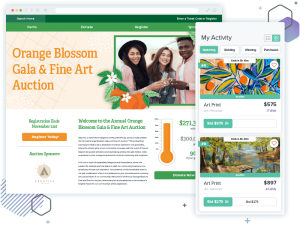The summer slowdown is real, but that doesn’t mean you should stop fundraising! Instead, focus on ways you can ensure your organization remains productive during the summer months with these nonprofit management tips! Plan summer fundraising campaigns and events and prep for the fall and winter months when giving picks up again.
Keep fundraising during the summer
Individual giving tends to slow during the summer months for most organizations. Now is the time to give your donors a little push to continue their fundraising. You can accomplish this by launching a summer fundraising campaign or hosting peer-to-peer fundraising events.
Summer Fundraising Campaigns
Here’s a simple nonprofit management tip for keeping donors giving during the summer. Ask them to support your nonprofit with recurring donations. Launch a fundraising campaign at the start of summer and keep it going all summer long. The focus of the campaign should be on signing up donors for recurring gifts.
Recruiting your donors to give automatically with a recurring gift is a great way to keep funds flowing in during the summer months when many donors temporarily stop giving. Let donors know you need their help to continue providing your programs and services throughout the summer.
Calculate how much it costs to provide services throughout the summer months. When you have that dollar amount, focus the campaign on that fundraising target. Your donors will appreciate having a goal to work toward—especially if it means ensuring you’re still able to operate during the summer.
A well-executed fundraising campaign can boost fundraising throughout summer and beyond. At the end of the summer campaign, thank those who signed up to give recurring gifts. Ask them to continue showing their support by keeping their recurring donations active.
Accepting recurring donations is easy for Qgiv users. Donors can specify a recurring gift amount and frequency on standard Qgiv donation forms.
Summer Fundraising Events
What’s summer without fun stuff to do? Your nonprofit could provide a great way for donors to beat the heat and you can benefit from registration fees, peer-to-peer fundraising, sponsorships, raffles, and silent auctions. A fun peer-to-peer event planned during a week when your city’s event calendar looks sparse can bring out supporters in droves. Developing summer fundraisers and executing them well is a nonprofit management tip that helps your nonprofit make more money while providing value to your donors.
Finding the right summer event doesn’t have to be difficult. In fact, we’ve put together a list of summer fundraising event ideas. The trick is to find an event idea that resonates with your donors and is appropriate for the summer season. You’re limited only by your event budget and creativity. This summer, you’ll want to focus on making these events safe for your supporters during the ongoing COVID-19 pandemic. Check out this session on virtual events and ensure your event is fun and safe!
Prep for fall fundraising
In addition to summer fundraising campaigns and events, there are other ways to keep busy during the summer. Our next nonprofit management tip is to prepare for when donations pick up in the fall and winter. Use this time to develop your end-of-year campaign messaging, clean up your donor database, use donor prospecting tools to learn more about your donors, reach out to donors personally and ask them to support you in the fall, etc. Your summer to-do list can be a great help in getting the groundwork laid for an exceptional year-end fundraising campaign. Fun fact: many donors start researching what nonprofits they’ll support with end-of-year donations as early as September. Get ready for them!
Develop your end-of-year strategy
Summer is the perfect time to figure out your end-of-year fundraising strategy. Take the slow summer months to figure out how much money your nonprofit still needs to raise to reach its annual fundraising goal. Based on that information, strategize for how you’ll get there. Should you push recurring giving? What about a matching gift campaign? Have direct mail or email campaigns been effective or is it time to try a new strategy like text fundraising for your year-end campaign?
Develop your story
It’s also important to develop a great story to tell in your appeal to donors. Who has a story to share? Will their story inspire donors to give? What perspective should you tell the story from? Do you have permission to share their story and likeness with donors? Answer these questions and determine which story has the closest correlation to the reasons your donors give. Then, write it and design the appeal.
Dig into your donor database
Your database contains a wealth of information on your organization’s donors. An important nonprofit management tip is to take time to make sure your data is accurate and up to date. That’s because with accurate information on your donors you can easily determine which appeals worked for them, what their typical giving amount is, how often they give, as well as personal information like addresses and phone numbers. Analyze that data to determine what inspires donors to give, the appropriate dollar amounts of asks for each donor segment, etc.
Next, do a quick audit of donor addresses and phone numbers. Using a donor prospect tool or mass mailing software is an easy way to check that your donor database contains the most accurate address information for your donors. If your CRM supports it, you can likely import new addresses directly to your donor records from these sources so updating each address becomes a simple process.
Having an updated database and putting the data within to good use is key to showing donors you know them and their giving habits. That’s what makes this nonprofit management tip so important. Craft appeals catered to each specific donor segment and build your mailing, emailing, and text contact lists based on your donors’ preferences. You can likely determine those preferences by examining your donor data.
Connect with donors for non-asks
In preparation for your year-end campaign, take time to call and connect with your donors. This is one of the easiest nonprofit management tips to implement. Your donors want to hear from you and you should want to build on your connection with them. Focus on your current donors (those who gave to you within the last twelve months). Check in with them, thank them for supporting you, update them on what they’ve accomplished by funding your organization, and let them know you look forward to their continued support.
While on the call, ask questions and spend more time listening than talking. This helps you determine your donor’s feelings about your organization and learn what motivates them to give. If you want to try a different approach for your year-end appeal, like text fundraising, ask donors if they’d object to receiving text messages from your organization. You never want to send a text appeal out of the blue to donors who haven’t opted in to receiving text messages. It hurts your credibility and can come off as spam or an attempted scam. Respect your donor’s wishes when they answer and send appeals that match their preferences.
Conclusion
During summer months, nonprofits often see a decline in giving. That doesn’t mean that development professionals should stop fundraising. Instead of slowing down, use these nonprofit management tips to keep donations coming in like fundraising campaigns and events or at least lay down the groundwork for an awesome year-end appeal. Take the summer slowdown as a time to connect personally with donors too. Learn more about your donors and update your donor database. Your future self will thank you for it.


